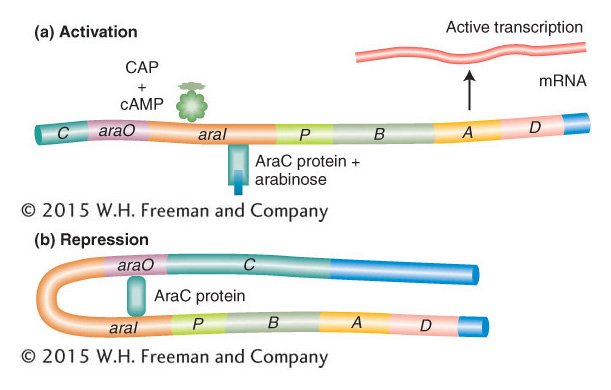11.4 Dual Positive and Negative Control: The Arabinose Operon
Figure 11-19: Map of the ara operon

Figure 11-19: The B, A, and D genes together with the I and O sites constitute the ara operon. O is araO and I is araI.
As with the lac system, the control of transcription in bacteria is neither purely positive nor purely negative; rather, both positive and negative regulation may govern individual operons. The regulation of the arabinose operon provides an example in which a single DNA-binding protein may act as either a repressor or an activator—a twist on the general theme of transcriptional regulation by DNA-binding proteins.
Figure 11-20: AraC serves as an activator and as a repressor

Figure 11-20: Dual control of the ara operon. (a) In the presence of arabinose, the AraC protein binds to the araI region. The CAP-cAMP complex binds to a site adjacent to araI. This binding stimulates the transcription of the araB, araA, and araD genes. (b) In the absence of arabinose, the AraC protein binds to both the araI and the araO regions, forming a DNA loop. This binding prevents transcription of the ara operon.
The structural genes araB, araA, and araD encode the metabolic enzymes that break down the sugar arabinose. The three genes are transcribed in a unit as a single mRNA. Figure 11-19 shows a map of the ara operon. Transcription is activated at araI, the initiator region, which contains a binding site for an activator protein. The araC gene, which maps nearby, encodes an activator protein. When bound to arabinose, this protein binds to the araI site and activates transcription of the ara operon, perhaps by helping RNA polymerase bind to the promoter. In addition, the same CAP–cAMP catabolite repression system that prevents lac operon expression in the presence of glucose also prevents expression of the ara operon.
Page 414
In the presence of arabinose, both the CAP–cAMP complex and the AraC–arabinose complex must bind to araI in order for RNA polymerase to bind to the promoter and transcribe the ara operon (Figure 11-20a). In the absence of arabinose, the AraC protein assumes a different conformation and represses the ara operon by binding both to araI and to a second distant site, araO, thereby forming a loop (Figure 11-20b) that prevents transcription. Thus, the AraC protein has two conformations, one that acts as an activator and another that acts as a repressor. The on/off switch of the operon is “thrown” by arabinose. The two conformations, dependent on whether the allosteric effector arabinose has bound to the protein, differ in their abilities to bind a specific target site in the araO region of the operon.
KEY CONCEPT
Operon transcription can be regulated by both activation and repression. Operons regulating the metabolism of similar compounds, such as sugars, can be regulated in quite different ways.

